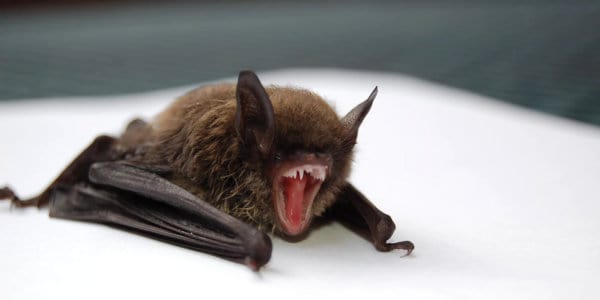One bone-chilling afternoon in early February, with the temperature at minus 20, I heard an odd commotion at my front door. My dog, Vimy, usually lies there on the porch to keep track of what is happening in the neighbourhood. Much to my surprise I saw her staring, in obvious alarm, at a brown bat lying on the mat in front of her, frantically flailing its wings. Realizing the bat would quickly freeze to death on the frigid surface, I decided to act quickly and save it, without having much of a clue about what to do. Searching around in the basement, I located a large jar with a lid, put on some heavy gloves, and returned to the porch. The bat was still flapping its wings in a futile attempt to become airborne.
Unsure of my next move, I bent down and cautiously closed my gloved hand around its small body as its mouth, exposing a set of sharp teeth, opened and closed, making weak, frantic cries. Its beady little eyes peered at me in sheer terror, as if pleading with me not to hurt it. Slowly I eased it into the jar, closed the lid, and brought it inside.
My obvious next step was figuring out what to do with a bat inside my house. I was determined to guard against the possibility of it escaping into a hidden corner of some closet in one of my bedrooms. Fumbling around, I spotted an empty aquarium on a shelf in my basement and decided that this would be the bat’s temporary home. After transferring it to the glass enclosure the bat settled down and appeared to go to sleep. No doubt it was comforted by the warmth of its new surroundings and relieved that it was now out of the extreme cold.
Needing some expert advice, I called my neighbor, whose husband is a research professor at McMaster University. She called Reuven at work who consulted a colleague who just happened to be an expert on bats. Apparently, my visitor was almost certainly a big brown bat, a species common to this area. It is not an endangered species as it is the most common and widespread bat in North America. Nevertheless, I was determined to try to give it a chance to survive.
That very evening, Reuven, armed with bat information, arrived at my door to help. He gingerly fed the startled bat with water from an eye dropper and used tweezers to give it some mealy worms from a tube full of these squirming insects. His colleague advised that periodic feeding would build up its strength, and when the weather warmed up, I could let it go outside where it would find shelter to complete its hibernation. For the next several days the bat was more interested in its new-found warmth than eating, and so, except for periodic nourishment, it just slept.
After doing a little research, I learned that extreme cold would prompt bats to relocate from their chosen winter quarters if the cold became too severe. It struck me that my bat may have come from the house next door because there appeared to be an obvious hiding place nearby in the side of their house next to my porch. There was a small opening in the wall where a window had been removed, but not as yet replaced. It was stuffed with insulation material, some of which was protruding from the opening. It appeared to be an obvious winter home for bats. It is possible that this bat, awakened by the extreme cold, decided to look elsewhere for shelter and crash-landed on my porch where my surprised dog discovered it.





